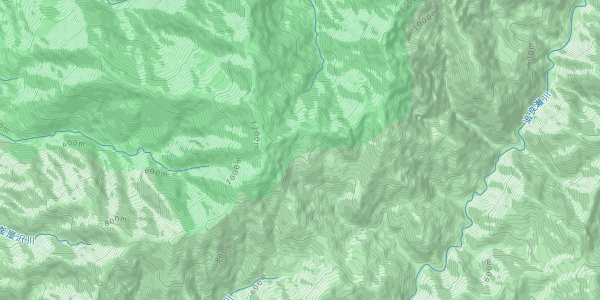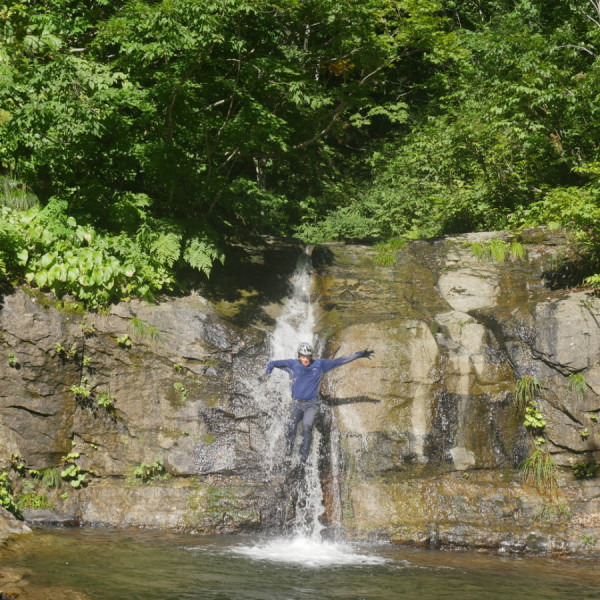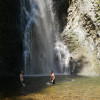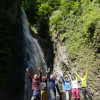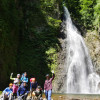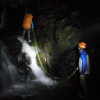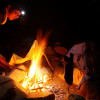Wednesday August 10, 2016
Details
Second announcement: 11.–14. Aug, SHIRAKAMI Adventure
This is the second announcement for the Shirakami hike this August.
The Shirakami (White God) mountain range is one of the very rare place untouched by human activity. This virgin beech forest is designated a natural Unesco World Heritage and located in the north of Japan`s main island stretching over Akita and Aomori prefecture.
We will be exploring the core zone of Shirakami sanchi, going mostly along creeks and rivers, but also navigating through some forest with map and compass. There are no marked trails in the core zone, and this hike includes some canyoning, or Sawa-nobori as the Japanese say. We will bring a rope to go up and down a waterfall. We will camp in the
forest and carry all our supplies.
Night bus tickets are already sold out in the busy O-bon week. That means we are going by car, leaving Aug. 10th at 8pm from Tsukuba Center and returning Aug. 14th at night (depending on traffic condition).
Estimated cost: roughly 15000 yen per person (depending on number of cars and participants)
People signed up so far are:
Rick
Eri
Thierry
Mihoko
Martin
If you are interested in this hike, please let me know as soon as possible. Number of participants is limited. I would like to close the registration by the end of this week, so we can coordinate transportation and equipment with the participants. We also need to
send our application to enter the core zone of shirakami sanchi to the forest ministry beforehand.
Here are a few impressions from our first exploration last year and my recent trip:
https://goo.gl/photos/ZYEXy7bk8LHTX93G8
Best regards,
Martin
This is an (early!) first announcement for the Shirakami hike this August.
You should know early about it to have a chance to plan ahead for your
O-bon vacation this year, when the hike is going to take place.
The Shirakami (White God) mountain range is one of the very rare place
untouched by human activity. This virgin beech forest is designated a
natural Unesco World Heritage and located in the north of Japan`s main
island stretching over Akita and Aomori prefecture.
We will be exploring the core zone of Shirakami sanchi, going mostly along creeks and rivers, but also navigating through some forest with map and compass. There are no marked trails in the core zone, and this hike includes some canyoning, or Sawa-nobori as the Japanese say. We will bring a rope to go up and down a waterfall. Depending on the interest of the participants we will keep this to a minimum or explore further. We will
camp in the forest and carry all our supplies. Means of transportation is either night bus (leaving on 10. Aug. at night, coming back 15. Aug. morning). In case we have enough drivers (two per car, to switch drivers since it is an 9 hour drive) we might go by car (leaving 10. Aug. at night, coming back 15. Aug. evening). Dates are not yet completely fixed.
Estimated cost: night bus ~14.000 yen (+ onsen, club fee, ...)
At this stage, I will be happy to hear from people who are interested in this hike. You can sign up already, or ask me questions if you are not yet sure what to expect.
Organiser
Report
Shirakami Sanchi Hike/Sawanobori Report: August 11. – 14.
We left Tsukuba Center at 8pm with two cars, one private and one rental. The initially intended ride by night bus was not possible, since all tickets were sold out long before O-bon. Nevertheless, cars gave us more flexibility and the total cost was about 13,000 yen per participant. With at least two drivers per car, we drove through the night with very smooth traffic conditions and arrived at 3am in Hirosaki, Aomori prefecture. After taking a rest till as well as breakfast at a combini, we presumed the last bit of the drive to arrive at 7am at Aqua Green Village Anmon, our official start of the hike.
The route we took over the four days in brief:
Day 1: (Start 8am) Anmon Village – Anmon Waterfalls (3, 2, 1) – Nishimata-sawa valley – through forest, entering Shirakami Sanchi Core Zone – Yanadaki-sawa – Base camp at Akaishi-kawa (Arrive 7pm)
Day2: (Start 10am) Base camp – all along Akaishi-kawa up to Yodome no Taki (20m waterfall, 40min time to play) – Back to base camp (Arrive 7pm)
Day 3: (Start 11:20am) Start to head back out of core zone: Akaishi-kawa downstream – Forest route Kumagera no Mori – Reaching Nishimata-sawa (Arrive 5pm) camp
Day 4: (Start 7am) Nishimata-sawa – Anmon Taki – Anmon Village (Arrive 12am) Onsen 1h, start drive back to Tsukuba 2pm, Arrive Tsukuba at night 1am
Weather: Sunny, partially cloudy, no rain for the four days
River water: Low, with little rain fall in the whole previous month
A general comment first: This hike is difficulty level five out of five. It involves going along rivers and streams (Canyoning /Sawanobori), abseiling a waterfall, navigating forest without set trails. Previous application to enter the core zone of Shirakami has to be submitted to the forestry office. People entering the core zone need to have skills of navigating with map and compass, as well as self-rescue skills in case something happens.
Our first day was a long hike with full luggage all the way in to Akaishi-kawa where there is two, three spots of nice wide river bank to camp. In general flat ground is extremely limited so we that there is not much other choice of accommodating seven people. For the same reason, I set the maximum number of participants to seven. After setting all our gear, we started the hike as planed at 8am in the morning. In addition to the previously submitted hiking schedule+route and application form, I left a copy at the small office at the entrance to the trail to Anmon-taki. Asking the White Goddess of this mountain range (the literal meaning of Shirakami Sanchi) for her blessing, we set out for a first hour on a rather touristy trail up to Anmon Waterfalls. Because of rock fall this year, the usual planks and bridges for this part were not set up, however with crossing through the river once or twice this was no problem. Anmon Waterfalls consist of three beautiful falls, each more than 20m high. To proceed further after the last fall, we climb up a very steep Maki-michi (bypass route of the waterfall), holding on to routs and vegetation. This is definitely the barrier which keeps out normal people from entering further into this untouched nature. From there on we walk in the stream of Nishimata-sawa for about 2h, reaching three smaller waterfalls (3-4m) at the upstream part of the valley. Two waterfalls are possible to climb up directly and one is bypassed by a (rather slippery) maki-michi. We leave the valley and climb up a ridge navigating through the forest and further small valleys, to finally climb up to cross over from the buffer zone into the actual core zone of Shirakami Sanchi. The forest “trails” (as said before, there are no set trails) are recognizable as something like a deer trail, which by carefully following the right direction is possible to navigate rather quickly. In preparation of the hike I had been in Shirakami Sanchi a
month ago for five days, so that I knew the routes. Walking the trails for the first time involves searching for the right way taking up considerable time, which as it turned out we did not have this time anyways. The last section all the way down to Akaishi-kawa, our
intended camp site, goes along another valley, with long slippery slabs of dark black rock. Our walking speed was decreasing considerably due to the difficulty. Here the extra grip of
sawanobori-shoes with felt soul made a huge difference, even though even those sometimes slip on parts overgrown with algae. Nightfall was now approaching fast, but we could help each other down this last part by carrying backpacks and supporting each other. As the final decent, we put on climbing harnesses to abseil down a 20m cascading waterfall. Double checking the knots, we went down one by one, the last three of us already in the half-dark with headlights on. It was really good that all of the participants had gone down some climbing rope before in their lives, because there was actually no time to practice on a tree or so. Luckily our camp site was just down this waterfall and
another 5min to Akaishi-kawa. Putting up tents and tarps, we ate dinner and slept.
The second day we set out at 10am with light luggage, leaving everything else at our base camp with the food tight up on the rope in the tree. We were of different opinion about how smart monkeys are and if our construction was actually enough to prevent bears and monkeys from reaching our food. It turned out to be alright. Our route this day simply goes up the Akaishi-kawa with the goal of reaching a really nice and big waterfall and returning the same way. The prospect of reaching our goal was motivating enough, that we kept on going, even though we knew that we might barely make it before nightfall (again).
It was completely worth it: climbing parts of the waterfall, jumping into the water, swimming, taking pictures. And we did make it back just at sunset! Around a warm camp fire we ate and drank. Thanks Rick, for carrying the extra load of delicious foods and bourbon to share.
Exactly these two days was the peak of the Perseid meteor shower. We could see about one shooting star every ten minutes (if we looked long enough away from the fire to adjust our eye that is).
After two very long days, we had two more days to get out of the forest again. Exploring the river a bit in the morning, eating breakfast and packing up, we set out at 12am. Using a different route we went down Akaishikawa, had another swim and climbed up the forest.
Spotting many different kinds of mushrooms (most of them inedible, but very interesting colors and shapes) and a Mamushi snake, we navigated our way through beech forest and thick Sasa shrubbery. Everybody worked together really well as a team, helping down slippery and steep parts. At 5pm we made camp, this time with more limited space fitting
four people under the tarp and putting up another two and one person tent.
Almost everybody slept in and missed the Zazen or morning stretch at five o`clock in the morning, getting woken up at 6am to start the day.
And from 7am the last section everything backwards: going down the three minor waterfalls, walking the nice flat river bed of Nishimata-sawa, carefully crossing over and out the barrier back down to Anmon Waterfalls, another hour in the nicest sunshine along the river. Onsen (as always an essential part of hiking everybody looks forward to), we could take right at Anmon Village. With a long 650km drive ahead of us, we set out at 2am, stopping at a Michi-no-eki for a late lunch. With some Obon traffic jam in Tohoku and northern Ibaraki, we made it back at 1am at night to Tsukuba!
Thanks to all of the participants: Stephanie, Thierry, Rick, Eri, Floris, and Mihoko. I could rely on you and we made a great team! The difficulty and challenge of the hike only emphasises more the unique beauty and harmony of this untouched nature. Where else can you drink crystal clear water direcly from the stream? But isn`t it supposed to
be like that everywhere...
Thanks to the drivers, and especially to Eri for providing her car.
It follows a (very incomplete) list of plants, animals and mushrooms we saw:
- Animals: Firefly (big, flying high, still unidentified), Karasu-ageba (Bianor Peacock), Nihon-Mamushi (Mamushi Pit Viper), Tanuki ? (food prints), Nihon-shika ? (foot prints), ...
- Birds: Mountain Kingfisher (Yama-semi), Aobato (Japanese Green Pigeon), Wagtail (Sekirei), Brown Dipper (Kawagarasu), Jay (Kakesu)
- Mushrooms: Amanita rubrovolvata (Himebenitengutake), Pleurotus ostreatus (Hiratake) (ate), Amanita rufoferruginea (kabairokonarenngutake), (?)Amanita esculenta (Doushintake), Iguchi: (?) Boletus reticulates (Yamadoritakemodoki), Benitake, Lactarius volemus (Chichitake), and so many more
- Edible wild plants: Mitsuba, Ashitaba, Asami, Fuki (ate), Watercress Kurenso (ate), Uwabamisou (ate)
- Flowers: so many different ones, see pictures
Location
